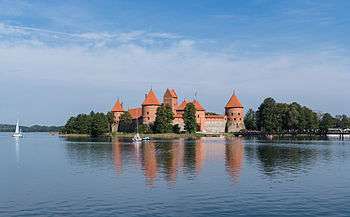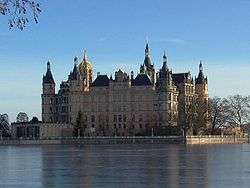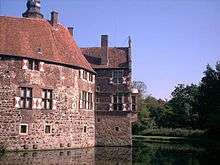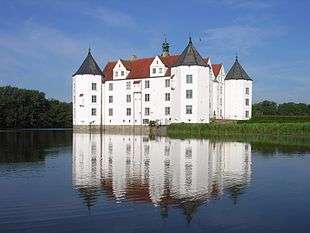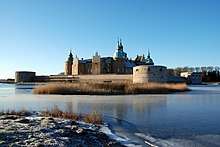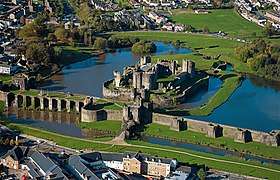Water castle
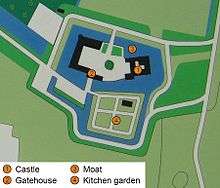
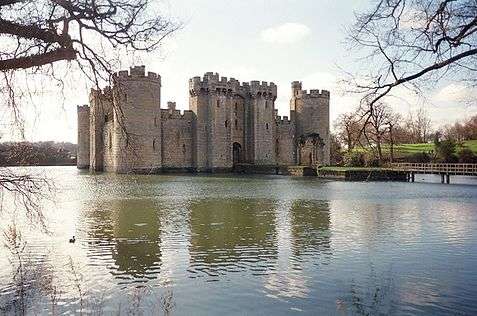
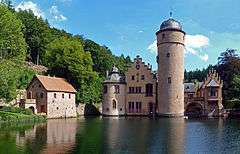
A water castle is a castle or stately home whose site is entirely surrounded by water-filled moats (moated castles) or natural waterbodies such as island castles in a river or offshore.
Description
Topographically water castles are a type of lowland castle. The term is mainly found in European-language sources, e.g. under its German names of German: Wasserburg or Wasserschloss, but is also used in English-language sources, usually those referring to European castles of this type. Forde-Johnston describes it as "a castle in which water plays a prominent part in the defences..."[1]
There is a further distinction between:
- Water castles, that are protected by artificial water-filled moats or ponds (man-made defences) i.e. a moated castle
- Water castles, whose primary means of protection is from river courses or which stand on islands in a lake or natural pond (natural defences). Island castles are an example.
In all cases, water is used as an obstacle to hinder an attacker. That apart, an abundant supply of water was also an advantage during a siege. Such a castle usually had only one entrance, which was via a drawbridge and that could be raised for protection in the event of an attack. To some extent these water castles had a fortress-like character.
Legacy
In many places in Central Europe castles that had formerly been fortified changed their role or were converted over the course of time so that they became largely representational and residential buildings. The characteristic moats thus lost their original security function, but were retained in some cases as an element of landscaping. Today, in monument conservation circles, they are often described as burdensome, cost-intensive "historic legacies" because of the water damage caused to their foundations. As a result, many moats around castles in Germany have been drained, or more rarely filled, especially since the 1960s.
Examples
Austria
Baltic
- Āraiši (Arrasch)
- Trakai Island Castle
Belgium
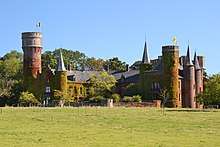
Czech Republic
- Blatná Castle
- Červená Lhota Castle
- Švihov Castle
Denmark
Finland
Germany

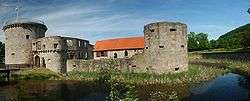

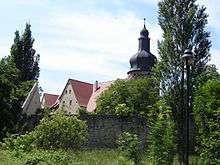
Baden-Württemberg
- Bad Rappenau Water Castle
- Inzlingen Castle
Bavaria
Berlin
Brandenburg
- Plattenburg in the Prignitz
Bremen
- Blomendal Castle
- Schönebeck Palace
Hamburg
- Bergedorf Palace
Hesse
- Friedewald Water Castle in Friedewald
- Fürstenau Palace near Steinbach
Lower Saxony
Mecklenburg-Vorpommern
North Rhine-Westphalia
- Benrath House in Düsseldorf
- Burgau Castle
- Gimborn Castle
- Haus Kemnade in Bochum
- Morsbroich Castle in Leverkusen
- Moyland Castle in Bedburg-Hau
- Nordkirchen Palace
- Rheydt Palace
- Dyck Palace
- Vischering Castle
- Wilkinghege Water Castle in Münster
- Wittringen Castle in Gladbeck
Rhineland-Palatinate
- Alte Burg (Boppard)
- Alte Burg (Koblenz)
Saarland
- Gustavsburg in Homburg
- Kerpen Castle near Illingen
Saxony
Saxony-Anhalt
- Calvörde Castle
- Köthen Castle
- Reinharz Water Castle
Schleswig-Holstein
Thuringia
- Kapellendorf Water Castle
Greece
Hungary
- Sárvár Castle
- Tokaj Castle (ruined)
Italy
- Castello Estense
- Castello di Sirmione
- in a broad way, Venice Arsenal
Japan
Netherlands
Portugal
Slovakia
- Parič Castle (ruined)
- Šintava Castle (ruined)
- Štítnik Water Castle
- Vranov Castle (vanished)
Slovenia
Sweden
- Älvsborg Fortress
- Bollerup
- Dybäck Castle
- Ellinge Castle
- Gåsevadholm Castle
- Gripsholm Castle
- Häckeberga Castle
- Hjularyd Castle
- Kalmar Castle
- Krageholm Castle
- Krapperup Castle
- Kronoberg Castle
- Kulla Gunnarstorp Castle
- Landskrona Citadel
- Malmö Castle
- Maltesholm Castle
- Örebro Castle
- Örup Castle
- Osbyholm Castle
- Skabersjö Castle
- Stegeborg Castle
- Strömsholm Palace
- Tosterup Castle
- Trolle-Ljungby Castle
- Trolleholm Castle
- Vadstena Castle
- Vaxholm Fortress
- Vegeholm Castle
- Vibyholm Castle
- Viderup Castle
- Vittskövle Castle
Romania
- Oradea Citadel
Switzerland
Turkey
United Kingdom
England
Scotland
Wales
References
- ↑ Great Medieval Castles of Britain by James L. Forde-Johnston (1979). Retrieved 20 Jul 2014.
External links
| Wikimedia Commons has media related to Water castles. |
